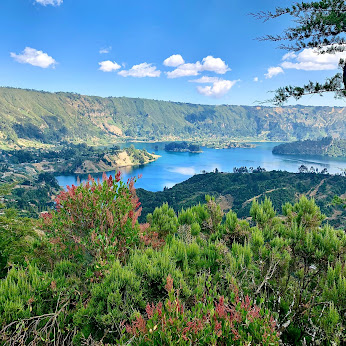𝐓𝐡𝐞 𝐞𝐧𝐜𝐡𝐚𝐧𝐭𝐢𝐧𝐠 𝐋𝐚𝐤𝐞 𝐖𝐞𝐧𝐜𝐡𝐢
Cradled by the lush green crater walls of this long-extinct volcano, Lake Wenchi lies in its contagious air of tranquillity, beckoning travelers to share in its beauty and experience the serenity of being not only surrounded by
but a part of, nature itself.
Wonchi
Wonchi is a place where you will find beauty everywhere and in everything. Whether you choose to take a mud bath or a dip in the cool, sapphire-blue lake, explore the area on horseback or go on a long hike, enjoy a picnic, or have an evening barbecue, this tranquil pocket of nature is a most wonderful place to spend a weekend.
The newly minted world's Best Tourism Village, Wonchi, contains Ethiopia's highest lake as well as its biggest lake inside of a crater. Dug out by a powerful volcanic eruption more than a thousand years ago, the lake has tall, gentle cliffs all around it. A special type of geography and volcanic geology has made Wonchi possibly the lake with the clearest water in the country. But you'd probably think it was green since that's what people see during the day as the crystal clear water reflects the vegetation around it so well. The cliffs around the lake are part of a series of rolling hills populated by indigenous trees that keep the ecosystem healthy. And the best part of all this? You can have a spectacular panoramic view of what Wonchi has to offer to stand on top of one of those hills. From the gorges smoking with fog to the shimmering lake and the small peninsulas protruding out into the gentle waves, Wonchi is a land made to delight all who get to see it.
![]() 𝐖𝐨𝐧𝐜𝐡𝐢 𝐂𝐫𝐚𝐭𝐞𝐫 𝐋𝐚𝐤𝐞 𝐒𝐞𝐥𝐞𝐜𝐭𝐞𝐝 𝐚𝐬 𝐎𝐧𝐞 𝐨𝐟 '𝐁𝐞𝐬𝐭 𝐓𝐨𝐮𝐫𝐢𝐬𝐦 𝐕𝐢𝐥𝐥𝐚𝐠𝐞𝐬 𝟐𝟎𝟐𝟏' 𝐁𝐲 𝐔𝐍𝐖𝐓𝐎!
𝐖𝐨𝐧𝐜𝐡𝐢 𝐂𝐫𝐚𝐭𝐞𝐫 𝐋𝐚𝐤𝐞 𝐒𝐞𝐥𝐞𝐜𝐭𝐞𝐝 𝐚𝐬 𝐎𝐧𝐞 𝐨𝐟 '𝐁𝐞𝐬𝐭 𝐓𝐨𝐮𝐫𝐢𝐬𝐦 𝐕𝐢𝐥𝐥𝐚𝐠𝐞𝐬 𝟐𝟎𝟐𝟏' 𝐁𝐲 𝐔𝐍𝐖𝐓𝐎!![]()
![]() Perched on 140 Km from the capital Addis Ababa, Wonchi is an area of exceptional beauty that some have referred to it as the "African Switzerland".
Perched on 140 Km from the capital Addis Ababa, Wonchi is an area of exceptional beauty that some have referred to it as the "African Switzerland".
The prestigious award will be given on the occasion of the 24th session of the UNWTO General Assembly by tomorrow, December 2, 2021, in Madrid, Spain.
The 'Best Tourism Villages' by UNWTO pilot initiative aim to award those villages which are outstanding examples of rural destinations and showcase best practices in line with its specified nine evaluation areas.


Comments
Post a Comment